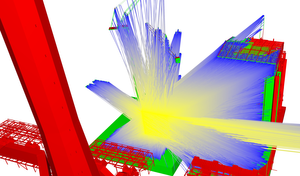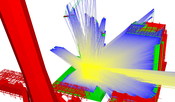Information
- Publication Type: Journal Paper with Conference Talk
- Workgroup(s)/Project(s):
- Date: April 2021
- Journal: Proceedings of the ACM on Computer Graphics and Interactive Techniques
- Volume: 4
- Open Access: no
- Number: 1
- Location: online
- Lecturer: Thomas Bernhard Koch
- ISSN: 2577-6193
- Event: ACM SIGGRAPH Symposium on Interactive 3D Graphics and Games
- DOI: 10.1145/3451266
- Call for Papers: Call for Paper
- Pages: 16
- Conference date: 20. April 2021 – 22. April 2021
- Pages: 4:1 – 4:16
- Keywords: visibility culling, real-time rendering, ray tracing
Abstract
Visibility computation is a common problem in the field of computer graphics. Examples include occlusion culling, where parts of the scene are culled away, or global illumination simulations, which are based on the mutual visibility of pairs of points to calculate lighting. In this paper, an aggressive from-region visibility technique called Guided Visibility Sampling++ (GVS++) is presented. The proposed technique improves the Guided Visibility Sampling algorithm through improved sampling strategies, thus achieving low error rates on various scenes, and being over four orders of magnitude faster than the original CPU-based Guided Visibility Sampling implementation. We present sampling strategies that adaptively compute sample locations and use ray casting to determine a set of triangles visible from a flat or volumetric rectangular region in space. This set is called a potentially visible set (PVS). Based on initial random sampling, subsequent exploration phases progressively grow an intermediate solution. A termination criterion is used to terminate the PVS search. A modern implementation using the Vulkan graphics API and RTX ray tracing is discussed. Furthermore, we show optimizations that allow for an implementation that is over 20 times faster than a naive implementation.Additional Files and Images
Weblinks
- Github repo
Full source code - Entry in reposiTUm (TU Wien Publication Database)
- Entry in the publication database of TU-Wien
- DOI: 10.1145/3451266
BibTeX
@article{KOCH-2021-GVS,
title = "Guided Visibility Sampling++",
author = "Thomas Bernhard Koch and Michael Wimmer",
year = "2021",
abstract = "Visibility computation is a common problem in the field of
computer graphics. Examples include occlusion culling, where
parts of the scene are culled away, or global illumination
simulations, which are based on the mutual visibility of
pairs of points to calculate lighting. In this paper, an
aggressive from-region visibility technique called Guided
Visibility Sampling++ (GVS++) is presented. The proposed
technique improves the Guided Visibility Sampling algorithm
through improved sampling strategies, thus achieving low
error rates on various scenes, and being over four orders of
magnitude faster than the original CPU-based Guided
Visibility Sampling implementation. We present sampling
strategies that adaptively compute sample locations and use
ray casting to determine a set of triangles visible from a
flat or volumetric rectangular region in space. This set is
called a potentially visible set (PVS). Based on initial
random sampling, subsequent exploration phases progressively
grow an intermediate solution. A termination criterion is
used to terminate the PVS search. A modern implementation
using the Vulkan graphics API and RTX ray tracing is
discussed. Furthermore, we show optimizations that allow for
an implementation that is over 20 times faster than a naive
implementation.",
month = apr,
journal = "Proceedings of the ACM on Computer Graphics and Interactive
Techniques",
volume = "4",
number = "1",
issn = "2577-6193",
doi = "10.1145/3451266",
pages = "16",
pages = "4:1--4:16",
keywords = "visibility culling, real-time rendering, ray tracing",
URL = "https://www.cg.tuwien.ac.at/research/publications/2021/KOCH-2021-GVS/",
}


 author version
author version
